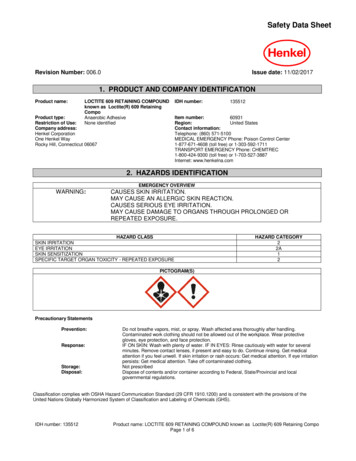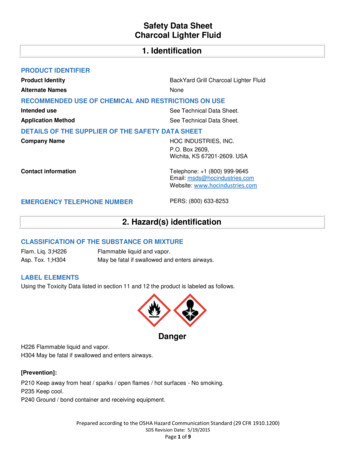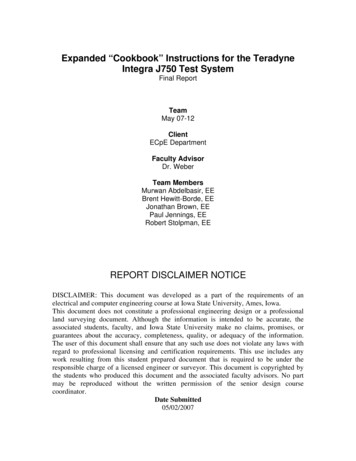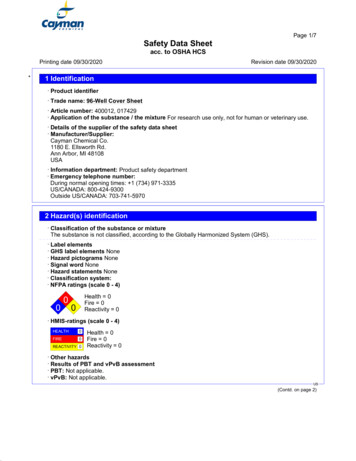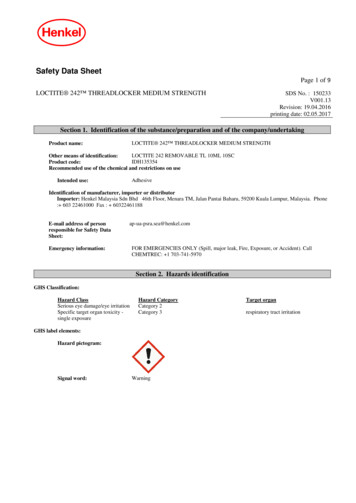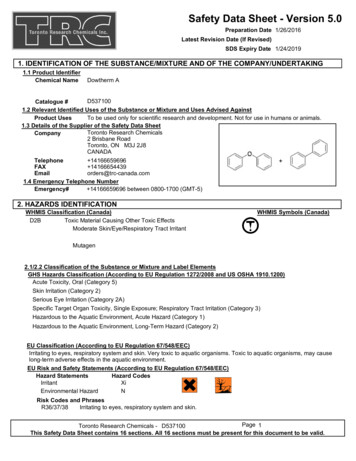
Transcription
Safety Data Sheet - Version 5.0Preparation Date 1/26/2016Latest Revision Date (If Revised)SDS Expiry Date 1/24/20191. IDENTIFICATION OF THE SUBSTANCE/MIXTURE AND OF THE COMPANY/UNDERTAKING1.1 Product IdentifierChemical NameDowtherm AD537100Catalogue #1.2 Relevant Identified Uses of the Substance or Mixture and Uses Advised AgainstProduct UsesTo be used only for scientific research and development. Not for use in humans or animals.1.3 Details of the Supplier of the Safety Data SheetToronto Research ChemicalsCompany2 Brisbane RoadToronto, ON M3J 2J8CANADATelephone 14166659696FAX 14166654439Emailorders@trc-canada.com1.4 Emergency Telephone NumberEmergency# 14166659696 between 0800-1700 (GMT-5)2. HAZARDS IDENTIFICATIONWHMIS Classification (Canada)D2BToxic Material Causing Other Toxic EffectsModerate Skin/Eye/Respiratory Tract IrritantWHMIS Symbols (Canada)Mutagen2.1/2.2 Classification of the Substance or Mixture and Label ElementsGHS Hazards Classification (According to EU Regulation 1272/2008 and US OSHA 1910.1200)Acute Toxicity, Oral (Category 5)Skin Irritation (Category 2)Serious Eye Irritation (Category 2A)Specific Target Organ Toxicity, Single Exposure; Respiratory Tract Irritation (Category 3)Hazardous to the Aquatic Environment, Acute Hazard (Category 1)Hazardous to the Aquatic Environment, Long-Term Hazard (Category 2)EU Classification (According to EU Regulation 67/548/EEC)Irritating to eyes, respiratory system and skin. Very toxic to aquatic organisms. Toxic to aquatic organisms, may causelong-term adverse effects in the aquatic environment.EU Risk and Safety Statements (According to EU Regulation 67/548/EEC)Hazard StatementsHazard CodesIrritantXiEnvironmental HazardNRisk Codes and PhrasesR36/37/38Irritating to eyes, respiratory system and skin.Page 1Toronto Research Chemicals - D537100This Safety Data Sheet contains 16 sections. All 16 sections must be present for this document to be valid.
R50Very toxic to aquatic organisms.Toxic to aquatic organisms, may cause long-term adverse effects in the aquatic environment.R51/53Safety Precaution Codes and PhrasesS23Do not breathe spray.S61Avoid release to the environment. Refer to special instructions.S26In case of contact with eyes, rinse immediately with plenty of water and seek medical advice.GHS Hazards Identification (According to EU Regulation 1272/2008 and US OSHA 1910.1200)Signal Word WarningGHS Hazard StatementsH303May be harmful if swallowed.H315Causes skin irritation.H319Causes serious eye irritation.H335May cause respiratory irritation.H400Very toxic to aquatic life.H411Toxic to aquatic life with long lasting effects.GHS Precautionary StatementsP261Avoid breathing dust/fume/gas/mist/vapours/spray.P273Avoid release to the environment.P305/P351/P338 IF IN EYES: Rinse cautiously with water for several minutes. Remove contact lenses, ifpresent and easy to do. Continue rinsing.2.3 Unclassified Hazards/Hazards Not Otherwise ClassifiedNo data available.3. COMPOSITION/INFORMATION ON INGREDIENTS3.1 SubstancesMolecular Formula:C12H10O.C12H10Molecular Weight: 324.42CAS Registry #: 8004-13-5EC#:Synonyms1,1'-Biphenyl Mixture With 1,1'-Oxybis[benzene]; Biphenyl-diphenyl Ether Mixture; Biphenyl-phenyl Ether Mixture;Dinil; Dinyl; Diphyl; Dowtherm; Therminol VP; Therminol VP 13.2 yl ether101-84-8202-981-2N/A73.5%4. FIRST AID MEASURES4.1 Description of First Aid MeasuresGeneral AdviceIf medical attention is required, show this safety data sheet to the doctor.If InhaledIf inhaled, move person to fresh air. If not breathing, give artificial respiration and consult a physician.In Case of Skin ContactWash affected area with soap and water. Consult a physician if any exposure symptoms are observed.In Case of Eye ContactImmediately rinse eyes with plenty of water for at least 15 minutes. Consult a physician.If SwallowedNever give anything by mouth to an unconscious person. Rinse mouth with water. Do NOT induce vomiting unlessPage 2Toronto Research Chemicals - D537100This Safety Data Sheet contains 16 sections. All 16 sections must be present for this document to be valid.
advised to do so by a physician or Poison Control Center. Seek medical attention.4.2 Most Important Symptoms and Effects, Both Acute and DelayedThe most important known symptoms and effects are described in the labeling (see section 2.2) and/or section 11.4.3 Indication of any Immediate Medical Attention and Special Treatment NeededNo data available.5. FIREFIGHTING MEASURES5.1 Extinguishing MediaUse water spray, alcohol-resistant foam, dry chemical or carbon dioxide.5.2 Special Hazards Arising from the Substance or MixtureCarbon oxides5.3 Advice for FirefightersWear self contained breathing apparatus for fire fighting if necessary.5.4 Further InformationNo data available.6. ACCIDENTAL RELEASE MEASURESPersonal precautionsWear respiratory protection. Avoid dust formation. Avoid breathing vapours, mist or gas. Ensure adequate ventilation.Evacuate personnel to safe areas. Avoid breathing dust.Environmental precautionsPrevent further leakage or spillage if safe to do so. Do not let product enter drains.Method and materials for containment and cleaning upPick up and arrange disposal without creating dust. Sweep up and shovel. Keep in suitable, closed containers fordisposal.7. HANDLING AND STORAGEPrecautions for safe handlingAvoid contact with skin and eyes. Avoid formation of dust and aerosols.Provide appropriate exhaust ventilation at places where dust is formed.Conditions for safe storageKeep container tightly closed in a dry and well-ventilated place.Keep in a dry place.Storage conditions: No Data Available7.3 Specific End UsesFor scientific research and development only. Not for use in humans or animals.8. EXPOSURE CONTROLS/PERSONAL PROTECTION8.1 Control ParametersComponents with workplace control parametersComponentsCAS-No.ValueControl parametersBasisDiphenyl ether101-84-8TWAEV1.000000 ppm7.000000 mg/m3Québec. Regulation respecting occupationalhealth and safety, Schedule 1, Part 1:Permissible exposure values for airbornecontaminantsTWAEV1.000000 ppm7.000000 mg/m3Canada. Ontario OELsSTEV2.000000 ppm14.000000 mg/m3Canada. Ontario OELsTWA1.000000 ppm7.000000 mg/m3Canada. Alberta, Occupational Health andSafety Code (table 2: OEL)Page 3Toronto Research Chemicals - D537100This Safety Data Sheet contains 16 sections. All 16 sections must be present for this document to be valid.
Biphenyl92-52-4STEL2.000000 ppm14.000000 mg/m3Canada. Alberta, Occupational Health andSafety Code (table 2: OEL)TWA1.000000 ppmCanada. British Columbia OELSTEL2.000000 ppmCanada. British Columbia OELSTEV2.000000 ppm14.000000 mg/m3Québec. Regulation respecting occupationalhealth and safety, Schedule 1, Part 1:Permissible exposure values for airbornecontaminantsTWA1.000000 ppmUSA. ACGIH Threshold Limit Values (TLV)STEL2.000000 ppmUSA. ACGIH Threshold Limit Values (TLV)TWA0.200000 ppmCanada. British Columbia OELTWAEV0.200000 ppm1.300000 mg/m3Canada. Ontario OELsTWA0.200000 ppm1.300000 mg/m3Canada. Alberta, Occupational Health andSafety Code (table 2: OEL)TWAEV0.200000 ppm1.300000 mg/m3Québec. Regulation respecting occupationalhealth and safety, Schedule 1, Part 1:Permissible exposure values for airbornecontaminantsTWA0.200000 ppmUSA. ACGIH Threshold Limit Values (TLV)8.2 Exposure ControlsAppropriate Engineering ControlsA laboratory fumehood or other appropriate form of local exhaust ventilation should be used to avoid exposure.Personal Protective EquipmentAll recommendations below are advisory in nature and a risk assessment should be performed by the employer/enduser prior to use of this product. The type of protective equipment must be selected based on the amount andconcentration of the dangerous material being used in the workplace.Eye/Face ProtectionSafety goggles or face shield. All equipment should have been tested and approved under appropriate standards, suchas NIOSH (US), CSA (Canada), or EN 166 (EU).Skin ProtectionGloves should be used when handling this material. Gloves are to be inspected prior to use. Contaminated gloves areto be removed using proper glove removal technique so that the outer surface of the glove does not contact bare skin.Dispose of contaminated gloves after use in compliance with good laboratory practices and local requirements.Gloves used for incidental exposures (splash protection) should be designated as “chemical resistant” by EU standardEN 374 with the resistance codes corresponding to the anticipated use of the material. Unrated gloves are notrecommended.Suggested gloves: AnsellPro Sol-Vex nitrile gloves style 37-175, 15 mil thickness.Penetration time has not been determined.Gloves used for prolonged direct exposure (immersion) should be designated “chemical resistant” as per EN 734 withthe resistance codes corresponding to the anticipated use of the material.Suggested gloves: AnsellPro Viton/Butyl gloves style 38-612, 4/8 mil thickness.Penetration time has not been determined.These recommendations may not apply if the material is mixed with any other chemical, or dissolved into a solution. APage 4Toronto Research Chemicals - D537100This Safety Data Sheet contains 16 sections. All 16 sections must be present for this document to be valid.
risk assessment must be performed to ensure the gloves will still offer acceptable protection.Body ProtectionFire resistant (Nomex) lab coat or coveralls.Respiratory ProtectionRecommended respirators are NIOSH-approved N100 or CEN-approved FFP3 particulate respirators. These are to beonly used as a backup to local exhaust ventilation or other engineering controls. If the respirator is the only means ofprotection, a full-face supplied air respirator must be used.9. PHYSICAL AND CHEMICAL PROPERTIES9.1 Information on Basic Physical and Chemical PropertiesA) AppearanceB) OdourNo Data AvailableNo data availableC) Odour ThresholdD) pHNo data availableNo data availableE) Melting Point/Freezing PointF) Initial Boiling Point/Boiling RangeNo data availableNo Data AvailableG) Flash pointNo data availableI) Flammability (Solid/Gas)No data availableK) Vapour PressureNo data availableM) Relative DensityNo data availableO) Partition Coefficient: n-octanol/waterNo data availableQ) Decomposition TemperatureNo data availableS) Explosive PropertiesNo data available9.2 Other Informationno data availableH) Evaporation RateNo data availableJ) Upper/Lower Flammability/Explosive LimitsNo data availableL) Vapour DensityNo data availableN) SolubilityNo Data AvailableP) Auto-Ignition TemperatureNo data availableR) ViscosityNo data availableT) Oxidizing PropertiesNo data available10. STABILITY AND REACTIVITY10.1 ReactivityNo data available.10.2 Chemical StabilityStable under recommended storage conditions.10.3 Possibility of Hazardous ReactionsNo data available.10.4 Conditions to AvoidNo data available.10.5 Incompatible MaterialsStrong oxidizing agents.10.6 Hazardous Decomposition ProductsIn the event of fire: See section 5. Other decomposition products: No data available.11. TOXICOLOGICAL INFORMATION11.1 Information on Toxicological EffectsA) Acute ToxicityOral LD50: Rat - 2,460 mg/kgDermal LD50: No data available.B) Skin Corrosion/IrritationModerate skin irritant.Inhalation LC50: No data available.Page 5Toronto Research Chemicals - D537100This Safety Data Sheet contains 16 sections. All 16 sections must be present for this document to be valid.
C) Serious Eye Damage/IrritationModerate eye irritant.D) Respiratory or Skin SensitizationNo data availableE) Germ Cell MutagenicityNo data availableF) CarcinogenicityNo data availableG) Reproductive Toxicity/TeratogenicityNo data availableH) Single Target Organ Toxicity - Single ExposureModerate respiratory tract irritation.I) Single Target Organ Toxicity - Repeated ExposureNo data availableJ) Aspiration HazardNo data availableK) Potential Health Effects and Routes of ExposureInhalationMay be harmful if inhaled. Causes respiratory tract irritation.IngestionMay be harmful if swallowed.SkinMay be harmful if absorbed through skin. Causes skin irritation.EyesCauses eye irritation.L) Signs and Symptoms of ExposureThe most important known symptoms and effects are described in the labeling (see section 2.2) and/or section 11.To the best of our knowledge, the chemical, physical, and toxicological properties of this material have not beenthoroughly investigated.M) Additional InformationRTECS: DV150000012. ECOLOGICAL INFORMATION12.1 ToxicityNo data available.12.2 Persistance and DegradabilityNo data available.12.3 Bioaccumulative PotentialNo data available.12.4 Mobility in SoilNo data available.12.5 Results of PBT and vPvB AssessmentNo data available.12.6 Other Adverse EffectsAn environmental hazard cannot be excluded in the event of unprofessional handling or disposal.Very toxic to aquatic life.13. DISPOSAL CONSIDERATIONS13.1 Waste Treatment MethodsA) ProductProduct may be burned in an incinerator equipped with afterburner and scrubber. Excess and expired materials are tobe offered to a licensed hazardous material disposal company. Ensure that all Federal and Local regulations regardingthe disposal and destruction of this material are followed.B) Contaminated PackagingDispose of as above.C) Other ConsiderationsPage 6Toronto Research Chemicals - D537100This Safety Data Sheet contains 16 sections. All 16 sections must be present for this document to be valid.
Product is not to be disposed of in sanitary sewers, storm sewers, or landfills.14. TRANSPORT INFORMATION14.1 UN NumberDOT (US): N/AIATA: UN3082IMDG: UN3082ADR/RID: UN308214.2 UN Proper Shipping NameDOT (US)/IATA:Not dangerous goods / Environmentally hazardous substance, liquid, n.o.s. (Diphenyl ether)IMDG/ARD/RID:ENVIRONMENTALLY HAZARDOUS SUBSTANCE, LIQUID, N.O.S. (Diphenyl ether)14.3 Transport Hazard Class(es)DOT (US): N/AIATA: 9IMDG: 9ADR/RID: 914.4 Packing GroupDOT (US): N/AIATA: IIIIMDG: IIIADR/
Chemical Name Dowtherm A Catalogue # D537100 Company Toronto Research Chemicals 2 Brisbane Road Toronto, ON M3J 2J8 CANADA Telephone FAX Email 14166659696 14166654439 orders@trc-canada.com Product Uses To be used only for scientific research and development. Not for use in humans or animals. WHMIS Classification (Canada) D2B Toxic Material Causing Other Toxic Effects


